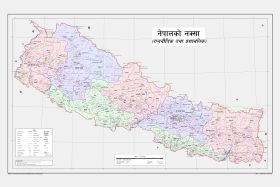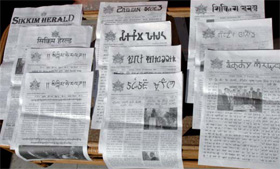Type in Nepali
Type in English, Get in Nepali
1. Please reload the browser, OR
2. Open (https://www.easynepalityping.com) on New Browser
Please wait, Nepali Language Translation is Loading … You can now type in Nepali in this text area …
Subscribe our Channel and Watch How to Type in Nepali Online
Visit our YouTube page to watch video on full screen.
How to Type Nepali Characters?
| Nepali Character | Roman Input Example (Type 'a') Press backspace or click on the word to see the list of letter candidates |
|---|---|
| अ | a |
| आ | aa |
| इ | i |
| ई | ii |
| उ | u |
| ऊ | oo or uu |
| ए | e or ae |
| ऐ | ai |
| ओ | o |
| औ | au or ao |
| ऋ | ri or rri |
| अं | an or am |
| अः | ah |
| Nepali Character | Roman Input Example (Type 'k') Press backspace or click on the word to see the list of letter candidates |
|---|---|
| क | k |
| ख | kh |
| ग | g |
| घ | gh |
| ङ | ng |
| च | ch |
| छ | chh |
| ज | j |
| झ | jh |
| ञ | ny |
| ट | tt |
| ठ | th |
| ड | d or dd |
| ढ | dh or ddh |
| ण | na or nn |
| त | t or ta |
| थ | th |
| द | d |
| ध | dh |
| प | p |
| फ | ph or f |
| ब | b |
| भ | bh |
| म | m |
| न | n |
| य | y |
| र | r |
| ल | l |
| व | v or w |
| श | sh |
| ष | sh |
| स | s |
| ह | h |
| Nepali Character | Roman Input Example (Type 'ksh') Press backspace or click on the word to see the list of letter candidates |
|---|---|
| । | Type . (decimal) |
| . | CTRL + SHIFT + . (decimal) |
| क्ष | ksh or xa |
| त्र | tr |
| ज्ञ | gya or jna |
| श्र | shr |
| र्रि | rri |
| द्द | dd |
| द्ध | ddh |
| र् | r (halant) |
Nepali Typing Tool Features
- Type in English, see it in Nepali – Simply type how words sound in English, and watch them transform into Devanagari script instantly.
Example: Type "Tapai lai kasto chha?" and it becomes "तपाई लाई कस्तो छ?"
- Multiple word suggestions – Not happy with the first suggestion? Press backspace or click on any word to see alternative options in a handy dropdown menu.
- Support for special characters – Insert Nepali punctuation and symbols effortlessly:
- Press the pipe key (|) next to Shift for purna viram "।"
- Press Shift + Ctrl + . to type a period "."
- Click the help button ( ) below the typing area for special characters (।, ॐ, ॥, ॰)
- Quick language toggle – Switch between English and Nepali instantly by pressing Ctrl + G.
- Auto-save feature – Your text is automatically saved locally for a week, so you won't lose your work if your browser crashes or computer shuts down unexpectedly. However, we recommend downloading or emailing your work rather than relying solely on browser recovery.
- Export your text – Copy, download, or save your Nepali text to any device with just one click.
- Send email in Nepali – Share your typed content with friends and family directly from this site – no need to open your email application!
- Completely free, always – No login required, no sign-up forms, no premium plans. This tool is 100% free and will remain free forever. Start typing immediately!
Tip: You can type as much as you like – there's no character limit, and everything happens in real-time!
Overview of the Nepali Typing Tool
We've made typing in Nepali incredibly straightforward—no complex keyboard layouts to memorise, no software to install.
Our online typing tool uses Google's trusted transliteration engine to convert phonetic Roman text (English alphabet) into Nepali script.
Here's how simple it is:
- Type how a Nepali word sounds in English.
Example: "namaste". - Press the Spacebar or Enter after typing the word to convert into Nepali script.
Result: "namaste" converts to "नमस्ते". - If you're not happy with the suggestion, simply press backspace or click the word to see alternative options.
The transliteration happens in real-time and handles unlimited text. Every time you press the spacebar, your text is automatically saved locally, ensuring it won't disappear if the browser closes or you revisit later. However, for crucial work, it is recommended to download or email your text rather than depending entirely on browser recovery.
Once you're done, you can copy the text, paste it into documents or blogs, share it on social media, or send it via email.
We'd love to hear how this tool helps you! Drop us a comment on our Facebook page, and if you find it useful, please share it with friends and family who might benefit from easy Nepali typing.
You don't need to learn a Nepali keyboard layout. Just type words phonetically in English, and they'll appear in Devanagari script.
Nepali Alphabet
Nepali Language
How to Integrate English to Nepali Transliteration?
Google Transliteration (Google Input Tool) provides phonetic typing from English to Nepali.
Although the official tool has been deprecated, you can still integrate similar functionality using community-maintained packages. Below are practical methods to implement English-to-Nepali transliteration on your website or application.
Frequently Asked Questions (FAQs) – Nepali Typing
References:
- [1] Central Bureau of Statistics, Nepal. "Language in Nepal - National Population and Housing Census 2021". Retrieved from https://censusnepal.cbs.gov.np/results/files/result-folder/Language in Nepal.pdf (URL no longer accessible)
- [2] Turner, R. L. "A Comparative and Etymological Dictionary of the Nepali Language". Digital South Asia Library, University of Chicago. Retrieved from https://dsal.uchicago.edu/dictionaries/turner /frontmatter/introduction.html
- [3] Unicode Consortium. "Devanagari Range: 0900–097F". Retrieved from https://www.unicode.org/charts/PDF/U0900.pdf
- [4] Unicode Consortium. "Nepali Font Standards". Retrieved from https://www.unicode.org/L2/L1999/99235.pdf
- [5] Michaelovsky, B. & Everson, M. "Proposal to Encode the Limbu Script in the BMP of the UCS". Unicode Consortium, 2001. Retrieved from https://www.unicode.org/L2/L2001/01137-SIRJ_IN7.pdf
- [6] Everson, M. "Introduction to the Lepcha Script". Unicode Consortium, 2003. Retrieved from https://www.unicode.org/L2/L2003/03259-intro-lepcha.pdf
- [7] Nepal Bhasa Movement. Wikipedia article documenting language suppression during the Panchayat era (1960-1990) and restoration of linguistic rights post-1990.
- [8] Ministry of Home Affairs, Government of India. "Constitutional Provisions Relating to Eighth Schedule". Retrieved from https://www.mha.gov.in/sites/default/files/ Eighth_Schedule.pdf
- [9] Joshi, Nisheeth and Mathur, Iti. "Input Scheme for Hindi Using Phonetic Mapping". Apaji Institute, Banasthali University, Rajasthan (2012). Retrieved from https://arxiv.org/pdf/1209.1300
- [10] sambhuWeb. "easytyping-google-input-tool". GitHub Repository. Retrieved from https://github.com/sambhuWeb/easytyping-google-input-tool
- [11] sambhuWeb. "google-input-tool". GitHub Repository. Retrieved from https://github.com/sambhuWeb/google-input-tool
- [12] Sanskrit-Coders. "indic_transliteration_py". GitHub Repository. Retrieved from https://github.com/indic-transliteration/indic_transliteration_py
Last Updated On:


